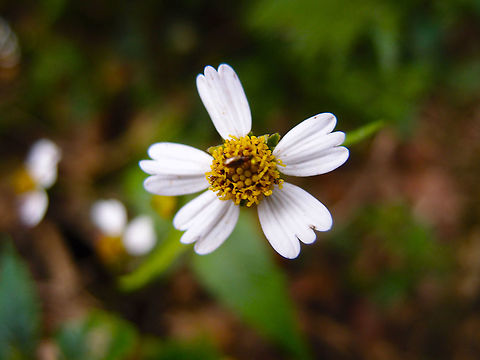
Appearance
''Bidens pilosa'' is a branched annual forb of gracile habit, growing up to 1.8 meters tall. It grows aggressively on disturbed land and often becomes weedy. The leaves are all oppositely arranged and range from simple to pinnate in form, the upper leaves with three to five dentate, ovate-to-lanceolate leaflets. The petioles are slightly winged.The plant may flower at any time of the year, but mainly in summer and autumn in temperate regions. The flowers are small heads borne on relatively long peduncles. The heads consist of about four or five broad white ray florets , surrounding many tubular yellow disc florets without ligules that develop into barbed fruits.
The fruits are slightly curved, stiff, rough black rods, tetragonal in cross section, about 1 cm long, typically with two to three stiff, heavily barbed awns at their distal ends.
The infructescences form stellate spherical burrs about one to two centimeters in diameter. The barbed spines of the achenes get stuck in the feathers, fur, fleeces, clothing, etc. of people or animals that brush against the plant. It is an effective means of seed dispersal by zoochory, as the fruits are transported by animals. This mechanism has helped the plant become a noxious weed in temperate and tropical regions. The barbed awns can injure flesh.
Naming
Its many English common names include black-jack,:819 beggarticks, hairy beggarticks, cobbler's pegs, devil's needles, hairy bidens, Spanish needle, farmers friend, Devils Pitchfork, and sticky beaks.Distribution
The species is native to tropical America, widely naturalized throughout the warm temperate and tropical regions of the world. A weed of gardens, woodlands, and waste areas.References:
Some text fragments are auto parsed from Wikipedia.